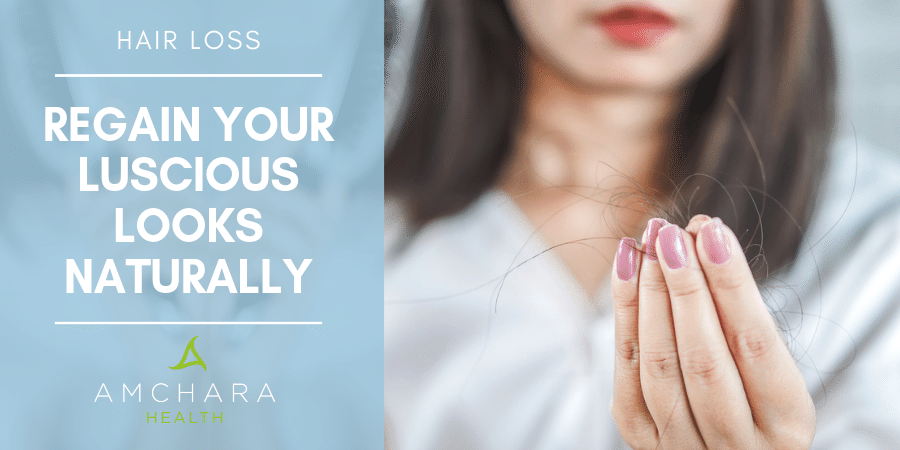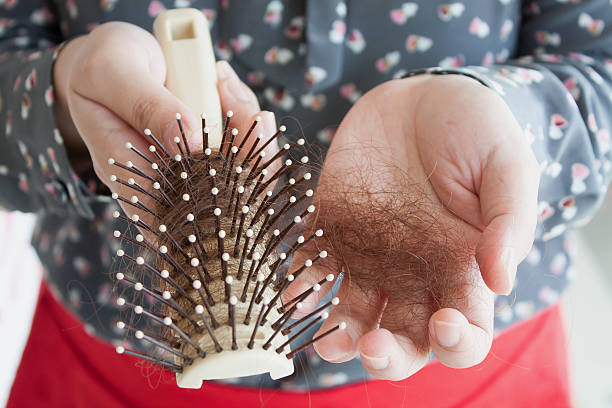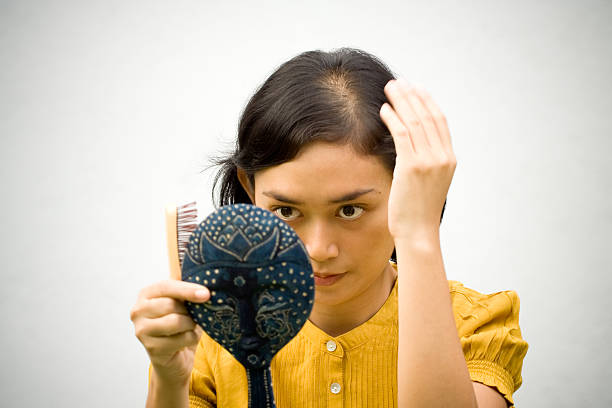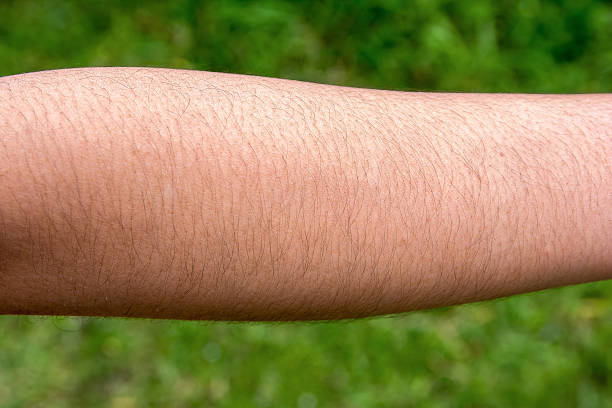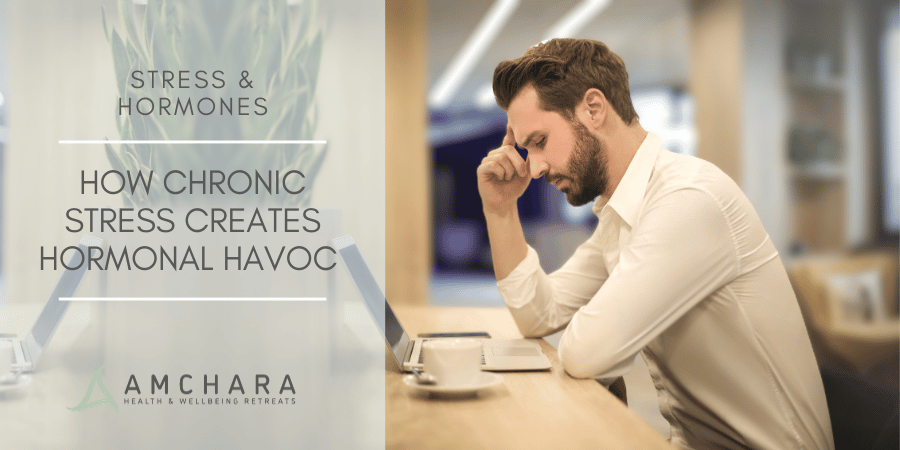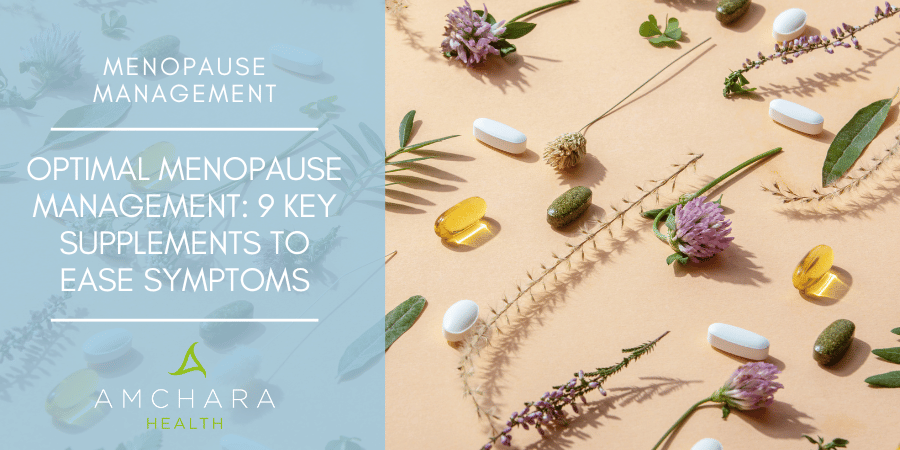Hair loss can be distressing, as hair can form such an important part of our appearance.
Equally, unwanted hair can be distressing.
Both have their roots in hormone imbalance.
Our mission is to provide you with insightful information.
We always take an evidence-based approach and aim to provide you with actionable knowledge and tips to help you on your journey to optimal health.
In this article, we’ll have a look at what causes hair loss and excess hair, and what can be done about these problems through balancing our hormones.
The hair cycle
Hair grows at different rates according to our genetics, but it’s usually between 0.5 and 1.5 cm per month.
Each hair grows in a small follicle, which scientists think acts as a tiny organ, responding to hormones produced locally in the skin. An average scalp has an impressive 84,000-145,000 hair follicles, although it varies according to hair colour. Natural blondes have more follicles than those with darker hair.
Hair is continually growing and shedding according to a specific cycle. Each hair strand grows for between 2 and 6 years. The active growing phase is termed the anagen phase. During this time, the root of the hair divides rapidly. An estimated 80-85% of your hair will be in this phase at any one time.
The next phase the hair will enter is the catagen phase, which lasts around 14 days. Only 1-2% of your hair will be in this phase, which is a transition phase. During this phase the blood supply is cut off from the hair shaft.
Finally the hair enters the telogen phase, which lasts between 1 and 4 months. During this phase the follicle is resting or dormant and the hair is shed. Between 12 -20% of your hair is usually in this phase, although certain conditions can cause more hair than usual to be in the telogen phase.
Sometimes it can seem alarming to see so many hairs on your hairbrush, but it’s perfectly normal to shed up to 100 hairs per day – it’s only a problem when we start to shed more hairs than we re-grow.
Telogen Effluvium is a term for for when more hair than normal is in the telogen phase, resulting in more hair than normal falling out. It usually only results in temporary hair loss and is often connected with stress.
Alopecia is a general term for hair loss, and although it’s mainly thought of as only affecting the scalp, hair can be lost from eyebrows, other facial hair and body hair.
Your hormones and your hair
High levels of androgens (male hormones) shortens the hair cycle. This is because hair does not have time to grow as long and becomes thinner – new growth is delayed so hairs aren’t replaced in time. This type of hormone imbalance leads to so-called male pattern baldness, or androgenic alopecia. Hair follicles become smaller than usual, as well as being a distinctive shape. The hair is lost from the head in a characteristic M-shape.
Male pattern baldness is responsible for an estimated 95% of hair loss in men. The NHS states it affects around half of all men in the UK by the age of fifty and can start as young as the late twenties.
However, male pattern baldness is not confined to men, as it also affects 30 million women in the USA, according to the National Institute of Health. Hair loss in women can be caused by many factors, but according to Alopecia UK, half of all women over the age of 65 years experience hair loss. Hair loss in women frequently occurs more widely over the scalp, although it often starts thinning in the central and forehead area. For those women affected, it can be very distressing.
Sometimes it’s tricky to tell if you are shedding more hair than usual, or if the strands of your hair are simply getting thinner, as can happen with age.
For a detailed discussion on the early signs of hair loss, see this article by the hair loss revolution.
What causes hair loss?
Hair loss can be triggered by stress, sudden weight loss, vitamin deficiencies, hormone imbalance or low protein intake – but sometimes no cause is obvious.
In women, hair loss is more common after the menopause, giving us a clue that in this case it’s likely to be hormone-related. In younger women, hair loss is common after pregnancy, which may be connected with nutrient deficiencies.
Sometimes hair loss can be caused by an autoimmune condition when the immune system attacks the hair follicles. Usually, hair follicles are not actually destroyed by the immune system, so it is possible for hair to grow back if this is the case.
One Taiwanese study found a correlation between hair loss and metabolic syndrome, which is associated with cardiovascular disease and Type 2 diabetes. It particularly seems to be connected with low levels of HDL (‘good’) cholesterol. (1)
Testosterone and hair loss
Male pattern baldness has long been blamed on high testosterone levels. Indeed, research has found (2) hair follicles from balding scalps contain higher levels of male hormones.
Androgen is the Greek word for ‘man maker’ – when we talk about androgens we are referring largely to testosterone. It’s this hormone which is largely responsible for male characteristics such as aggression and male sex drive, and it’s naturally produced by women too, although in much smaller amounts than by men.
However the picture is a bit more complex than simply the level of testosterone. Many of testosterone’s effects on the body don’t occur until it has been converted to a substance called Dihydrotestosterone, or DHT. The conversion process is made possible by an enzyme called 5 Alpha-Reductase.
Only around 10% of testosterone is usually converted to DHT. DHT has many positive effects on immune system regulation, cardiovascular health and improving memory. Research published in 2017 in JAMA Dermatology found no link between the actual levels of DHT or testosterone and hair loss. Hair follicles contain receptors which respond to DHT. It’s been suggested the problem may lie in the quantity of receptors or the sensitivity of these receptors to DHT.
Our sensitivity to male hormones is suspected to be down to genetics. We possess a gene known as the androgen receptor gene, which makes proteins known as androgen receptors. Variations in this gene may determine how sensitive our hair follicles are to male hormones.
What causes high testosterone in women?
In premenopausal women, testosterone is released by the ovaries and the adrenal glands. The adrenals usually secrete about a quarter of the testosterone that we produce. It can also be made from the stress hormone DHEA, which is also the starting molecule from which we make progesterone.
High levels of testosterone in women can be a knock-on effect from imbalances in our female hormones, problems with ovarian function, or polycystic ovary syndrome (PCOS). PCOS is characterised by multiple cysts on the ovary, irregular periods and difficulty losing weight, as well as excess body hair, although it is sometimes connected with thinning head hair too.
Occasionally, increased testosterone is connected with an inherited disorder which affects the production of hormones by the adrenal glands.
The female hormone oestrogen (3) helps to keep hairs in the growth period for longer. Oestrogen levels often drop after the menopause, causing thinning hair.
Excess hair is not good news
On the other end of the scale, female hirsutism (or excess hair) can be equally distressing as hair loss.
Although many women notice their body hair naturally increases as they age, in the case of hirsutism dark, coarse hair grows on the face, especially the upper lip, and the lower abdomen, chest and back. It’s not confined to older women, as it’s estimated 25-35% of younger women are affected.
Hirsutism in women is also related to high testosterone levels. PCOS is the most common cause of excess hair in women, accounting for 90% of cases.
Strategies to encourage healthy hair growth
Since both hair loss and excess hair are connected with disorders in androgen levels, let’s have a look at some measures you can take to encourage healthy hair growth.
- Manage stress
Some researchers have suggested stress and anxiety can raise testosterone levels by raising DHEA (4), from which testosterone can be made. It’s known that stress can lead to high oestrogen by stealing progesterone; this effect can last for as long as 1-2 months after the stressful event.
Remember the level of any one hormone in your body will affect the others. High oestrogen is connected with high testosterone, although the exact mechanism isn’t clear.
- Look after your thyroid
A thyroid gland which is not functioning at its best can adversely affect the production of proteins (5) by the hair follicles.
Women are around eight times more likely to develop hypothyroidism than men, particularly if oestrogen levels are high, as they tend to be in women who suffer from PMT or heavy, irregular periods which can suppress the thyroid.
If your thyroid is struggling symptoms can include – apart from hair loss – feeling the cold, dry skin, inability to lose weight and fatigue.
An overactive thyroid gland can also have an adverse effect on hair growth as the growth cycle speeds up. This means the hair ends up falling out more quickly than it can grow.
- Balance your sugar levels
In certain circumstances, cells don’t respond to the messages of insulin, a hormone which encourages them to use sugar for energy. This result of this is both high sugar levels in the blood and high insulin levels, which can eventually lead to Type 2 diabetes.
Insulin resistance makes it very hard to lose weight and to make matters worse excess fat can also increase testosterone production. (6) Balance your blood sugar levels by avoiding sugary and processed foods and sweet drinks, as well as coffee and alcohol, including some protein with every meal and snack, and exercising regularly.
Supplements
- Saw palmetto
Saw palmetto is the extract of a small palm tree found in South Eastern American states such as Florida. It has been found to decrease the conversion of testosterone to DHT (7) because it binds to the receptors for the enzyme 5 Alpha-Reductase, effectively blocking its action.
Most of the research carried out on saw palmetto has been in relation to prostate enlargement in men, in which DHT also plays a role. However, one study, which added saw palmetto to a hair lotion, saw a total increased hair count of 11.9%.
Saw palmetto has also been used successfully for excess hair in women, which might be expected because of its DHT-reducing properties.
- Beta-Sitosterol
This is a plant substance similar to cholesterol, naturally found in flax seeds, olive oil and soya.
In one study on men taking a supplement of beta-sitosterol, their blood levels of DHT were reduced by 40% after three months – although it has to be noted this study was funded by the manufacturers of the supplement.
Plant oils contain the highest concentration of plant sterols like beta-sitosterol.
Hair nutrients
It makes sense to ensure your hair is getting enough of the nutrients it requires for healthy growth.
- Iron
A frequent cause of shedding hair in women, low iron status (8) means your body can’t carry oxygen around the blood efficiently, and growth and repair of the hair follicles is affected.
Iron is found in red meat, particularly organ meats. Other good sources include shellfish, spinach, legumes, pumpkin seeds, tofu and dark chocolate.
- Zinc
Zinc is a mineral required by many enzymes involved in cell division. (10) Low zinc levels have been found to lead to hair loss and brittle hair.
Good sources of zinc include meat, shellfish and beans.
- Essential fatty acids
Sufficient linoleic and alpha-linolenic (omega-6 and omega-3) fatty acids may inhibit 5 Alpha-Reductase activity. (11) In doing so levels of DHT will be reduced. On the other hand omega-6 fats (12) may promote hair growth.
Essential fats are found in cold-pressed seed oils such as flax and hemp seed oils, nuts and seeds.
- B Vitamins
Deficiency of Niacin, a form of vitamin B3, has been linked in studies (13) to alopecia. In one study (14) which incubated sheep hair follicles in biotin (another B vitamin), both DNA and protein synthesis was increased. Low levels of B12 can affect the health of red blood cells which are essential for the replication of DNA. However, there is not a lot of research on the connection between vitamin B12 and hair loss.
B vitamins can be found in beans, lentils, seeds, nuts and whole grains, as well as green leafy vegetables.
- Vitamin D
The sunshine vitamin may play a role in the life cycle of the hair follicle. Studies have shown (15) an increase in vitamin D receptor transmission in the hair root during growth phases.
It’s now recognised that many people are deficient in Vitamin D in the UK – a great excuse to get out and about whenever the sun is shining.
- Selenium
Selenium is an antioxidant and plays a role in the lifecycle of the hair follicle. This is probably connected with its role in the formation of thyroid hormones. Rats given a diet low in selenium experienced reduced hair growth. (16)
The recommended daily intake of selenium according to the NHS is 60mcg for women and 75mcg for men.
According to Rothamsted research, selenium deficiency may affect at least one billion people worldwide. It’s caused by low levels in the soil, which in turn results in reduced levels in food crops. Owing to climate change, already low levels in the UK soil are projected to drop by a further 10%. According to the British Nutrition Foundation, because of the depleted soil levels of selenium, we are only getting an average of 39mcg per day from our diet.
Brazil nuts contain around 70mcg per nut, but this value will vary widely depending on where they were grown.
Too high a level of selenium (17) can cause toxicity and hair loss.
- Vitamin E
In one study, (18) volunteers were given 100mg vitamin E, and the number of hairs in a particular area of their scalp were counted. After 8 months there was a significant increase in the number of hairs, suggesting vitamin E stimulates hair growth.
Vitamin E is found in vegetable oils, nuts, seeds and green leafy vegetables.
- Antioxidants
Studies suggest (19) follicle cells from balding scalps are more susceptible to oxidative stress, leading to hair loss if antioxidants are in short supply.
Astaxanthin is an antioxidant derived from algae which in one study was found to inhibit 5 Alpha-Reductase (20) activity by an impressive 98% in a test-tube.
To ensure your diet contains a broad range of different antioxidants, eat a rainbow every day – antioxidants give plant foods their vibrant colours.
Takeaway
Losing hair where it’s supposed to be, and gaining hair where it shouldn’t, are both distressing conditions, but adopting the methods above could help to put things right. Because our hormones are intimately connected to and affect one another, figuring out what’s wrong can be difficult.
Did you find this article useful?
Please share your thoughts in the comments, we’d love to hear from you.
READ THIS NEXT:
